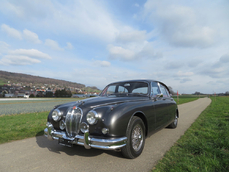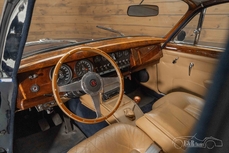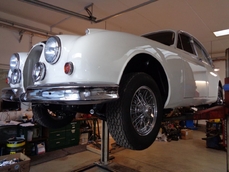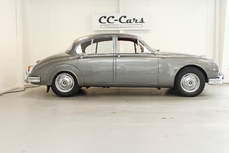Jaguar MkII 3.8 Saloon 1960
Allmän beskrivning :
From the mid-1950s onward, Jaguar enjoyed considerable success thanks in large part to its highly advanced "XK" family of twin-cam inline six-cylinder engines. This engine is best known for its tenure in the XK120, 140, and 150 sports cars, and in race trim, it powered the C-Type and D-Type sports cars to an impressive six victories in the 24h of Le Mans. While it will always be known for its sporting ability, the XK was quite versatile, and its power and refinement made the big Mk VII and Mk IX luxury saloons some of the best of the best of their class – while also capable of mopping up the competition in British Saloon Car racing with the likes of Stirling Moss and Roy Salvadori at the wheel.
The success of the large saloon cars allowed Jaguar to capitalize on its reputation with a new, smaller saloon that would appeal to a broader market. The new mid-sized four-door debuted in 1955, equipped with 2.4 or 3.4-liter versions of the twin-cam inline-six. The new car featured Jaguar's first-ever road-going monocoque chassis, with independent front suspension and a solid-rear axle shared with the XK sports car. It was clothed in curvaceous sheet metal that showed a family resemblance to its sporting brethren but was altogether unique in its form. Despite its smaller size and lower price point, it was still very much a Jaguar and therefore featured beautiful Connolly leather, wool rugs, and luxurious wood trimmings.
In 1959, Jaguar updated the previous 2.4/3.4 and renamed it "Mark II." The styling was freshened up with a larger greenhouse, and more delicate, chrome-trimmed window frames. However, the big news was the addition of the new 3.8-liter engine shared with the XK150, slightly detuned in twin-carburetor spec, but still highly effective in propelling the mid-sized four-door along with vigor. A large number of US-spec cars came with the Borg-Warner automatic transmission, but the pick of the enthusiast was the four-speed manual with Laycock de Normanville electric overdrive. Particularly when fitted with the 3.8 l engine and 4-speed manual 'box, the luxurious MkII is a formidable performance machine that could easily show proper sports cars a clean set of heels.
This lovely 1960 MkII is beautifully restored and equipped from the factory in the most desirable specification of a 3.8-liter engine with the 4-speed manual gearbox and Laycock overdrive. The high-quality restoration was performed over seven years by marque specialists in the UK, before returning to the USA in 2015 with its most recent owner. It features numerous upgrades and has been extremely well-maintained in top running condition. Finished in British Racing Green, the body is crisp and well detailed, with excellent paint and consistent gaps and panel alignment. It also features Coombs-style wheel spats, developed by racers to allow for a meatier rear tire to fit under the arches, giving this car a squat, purposeful stance on its beautiful chrome knock-off wire wheels and grippy 205-section radial tires. The brightwork is a blend of restored and well-preserved original items. Some of the minor trim parts, such as the door handles, and Jaguar "leaper" mascot show some slight pitting in the surface, while the bumpers, window frames, and moldings are excellent. The car has been dialed-in for performance driving in all conditions and features powerful H4 flat-lens headlamps and Cibie Iode 40 fog lamps.
The light velvet green leather provides an attractive complement to the exterior paint scheme. The seats are in good condition overall, noting only some slight fading and a minor flaw in the passenger seat piping. Green carpets and West of England broadcloth headlining are excellent, as are the matching green door panels. Burl walnut trim on the dash and door cards is glossy and attractive, although some slight cracking appears in the lacquer, particularly along the dash top. This car also features air conditioning, with vents and controls neatly integrated into the center console, along with a modern AM/FM/CD player. The interior presentation is capped off with a handsome, period-correct Derrington three-spoke steering wheel.
Receipts show this car received a complete engine overhaul and mechanical refurbishment in 2017. The engine block is a correct replacement 3.8-liter, topped with the original numbers-matching cylinder head. As part of the 2017 rebuild, it was bored over 0.040 inches and treated to a set of new Mahle 9:1 compression pistons, all new bearings, valves, gaskets, and a reground crankshaft. The block was also converted to a replaceable lip-style rear main seal, replacing the troublesome and leak-prone Archimedes rope seal. Other niceties include a lightweight aluminum flywheel, heavy-duty diaphragm-type clutch kit, high-torque starter, electronic ignition conversion, and a full stainless-steel exhaust system. Air conditioning and power steering work beautifully, and ensure this MkII is easy to drive and comfortable at all speeds. There is evidence of prior use on the undercarriage, but it is tidy and well detailed with quality finishes on the suspension components, Cunifer alloy brake lines, and body-color chip-guard for protection against rocks and weathering.
The more you look at this outstanding MKII, the more impressive the details become. Sensible, well-integrated upgrades ensure this car is user-friendly, while also delivering genuinely exciting performance. The restoration has mellowed gracefully, and the car feels on the button and ready to enjoy to the fullest. This highly-desirable Jaguar lives up to its title as the granddaddy of the modern sports saloon and is the perfect companion for fast-road driving in sophisticated style.
Offers welcome and trades considered
https://hymanltd.com/vehicles/6571
1960 Jaguar MkII 3.8 Saloon is listed såld on ClassicDigest in St. Louis by Mark Hyman for $79500.
Fakta i bilen
Karosstyp : Personbil Märke : Jaguar Modell : MkII Modellversion : 3.8 Saloon Motorvolym : 0.0 Årsmodell : 1960 Karosstyp : Sedan Läge : Missouri
Såld
Information om säljaren
Såld
People who viewed this Jaguar MkII also viewed similar Jaguar listed at ClassicDigest
Other cars listed for sale by this dealer
om Jaguar
Åh, historien om Jaguar, från dess tidiga dagar som SS Cars Ltd. till sin höjdpunkt med D-typen och gatubilsevolutionen i form av den ikoniska E-typen. Det finns något alldeles brittiskt över denna berättelse, och jag ska berätta den som en brittisk journalist skulle göra.
I början:
Vår resa in i Jaguar-världen börjar på 1930-talet, när ett företag som kallades SS Cars Ltd. dök upp. Trots den olyckliga sammanträffandet av deras initialer med de stigande politiska spänningarna i Europa började de producera stilfulla och prestandainriktade bilar. SS 100, som introducerades 1936, var en symbol för elegans och hastighet och lade grunden för vad som skulle bli Jaguar.
Jaguars födelse:
När skuggan av andra världskriget närmade sig beslutade SS Cars Ltd. klokt att distansera sig från SS-initialerna. Så 1945 blev de officiellt Jaguar Cars Ltd., ett namn som snart skulle bli synonymt med brittisk lyx och prestanda.
XK-serien:
Jaguars efterkrigstid gav oss XK 120, en verklig sensation 1948. Med sin strömlinjeformade design och en kraftfull 3,4-liters raksexmoters blev den världens snabbaste seriebil. XK 120 var ritningen för det som komma skulle - Jaguar som förenade stil med hastighet på ett unikt brittiskt sätt.
D-typens dominans:
Sedan kom D-typen, en sann racinglegend. Introducerad 1954, vann den Le Mans tre gånger på 1950-talet och visade Jaguars tekniska skicklighet. Med sin innovativa monokokkonstruktion och den ikoniska fenan bak var D-typen höjdpunkten av Jaguars framgång inom motorsport.
E-typens framträdande:
Men den verkliga vändpunkten kom 1961 med introduktionen av E-typen, ofta beskriven av Enzo Ferrari som "den vackraste bilen som någonsin byggts". Dess långa motorhuv, böljande kaross och en 3,8-liters motor som levererade upphetsande prestanda gjorde den till en omedelbar klassiker. E-typen var inte bara en bil; den var ett konstverk på hjul och kunde nå 150 mph på vägen.
Gata och racingsuccé:
E-typens skönhet matchades av dess förmåga på racerbanan. De lätta E-typarna var särskilt framgångsrika i olika racingevenemang och cementerade Jaguars rykte som en kraft att räkna med inom motorsport.
Raffinemangets ålder:
När vi fördjupar oss i Jaguar-historien finner vi att 1950-talet och 1960-talet var en tid av raffinering och expansion. Tillsammans med den magnifika D-typen och den ikoniska E-typens framträdande introducerade Jaguar modeller som ytterligare befäste sitt rykte för lyx och prestanda.
MK2:
I slutet av 1950-talet presenterade Jaguar MK2, en sportig sedan som kombinerade elegans med kraft. Denna eleganta fyradörrars salong var en favorit bland bankrånare och polisen, tack vare dess exceptionella hastighet och hantering. MK2 var en symbol för Jaguars förmåga att förena sofistikering med prestanda och hade också en framgångsrik racingkarriär.
XJ6:
Hoppa fram till 1968 och Jaguar lanserade en bil som skulle definiera lyxbilar i decennier framöver - XJ6. Det var ett mästerverk i teknik och design med en jämn raksexmoters, oberoende bakre fjädring och en rymlig, vackert inredd interiör. XJ6 var en symbol för brittisk elegans och erbjöd en så smidig åktur att det kändes som om den gled över vägen. Den blev flaggskeppsmodellen för Jaguar och satte standarden för lyxbilar och visade en nivå av raffinering som imponerade på konkurrenterna.
Blandningen av klassiskt och modernt:
Medan MK2 och XJ6 representerade utvecklingen av Jaguars sedanmodeller, bibehöll de märkets engagemang för prestanda och lyx. Dessa bilar hörde inte bara hemma på racerbanan; de trivdes lika bra på de stora boulevarderna som på en avslappnad körning genom den engelska landsbygden.
Utmaningarna av förändring:
Men när 1970-talet närmade sig, ställdes Jaguar, liksom många brittiska biltillverkare, inför ekonomiska utmaningar och ägarförändringar. British Leyland-eran förde både möjligheter och svårigheter med sig när varumärket navigerade genom olika sammanslagningar och övergångar.
Ändå fortsätter arvet från MK2 och XJ6, tillsammans med D-typen och E-typen, att definiera Jaguar som en tillverkare som förenar tidlös elegans med en anda av prestanda. Dessa klassiska modeller, vare sig de körs på slingrande vägar eller står som samlarföremål, tjänar som ett vittnesbörd om Jaguars långvariga närvaro inom den automobila exklens värld.
Jaguar-historien, från dess tidiga dagar som SS Cars Ltd. till skapandet av ikoner som E-typen, MK2 och XJ6, är en resa som speglar essensen av brittisk bilkultur - en blandning av lyx, kraft och stil som fortsätter att fängsla entusiaster och samlare över hela världen.











